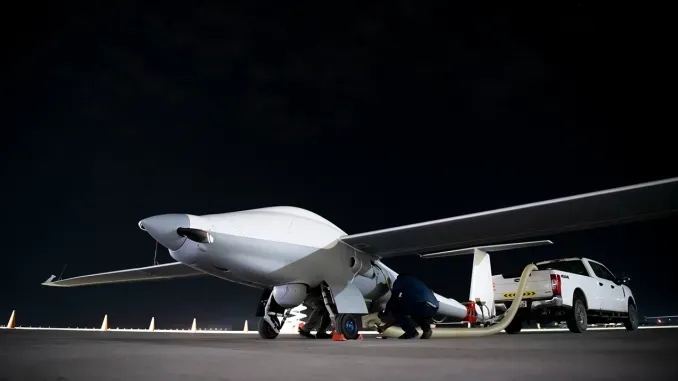
File photo: An Unmanned Long-endurance Tactical Reconnaissance Aircraft (ULTRA) attached to the US Air Force.
Recently, the US military deployed an Unmanned Long-endurance Tactical Reconnaissance Aircraft (ULTRA) to an air base in the United Arab Emirates (UAE), which represents the first appearance of this type of UAV in the Middle East. Military observer Zhang Xuefeng said that the UAV is characterized prominently by its long endurance and flexibility in choosing reconnaissance payloads for different missions.
Zhang pointed out that the wings of the glider-like UAV are designed to improve the lift-drag ratio and cruise efficiency to achieve maximum flight range. In addition, it is installed with a propeller power system to reduce fuel consumption. With these designs, this new model's duration of flight is extended to 80 hours. Furthermore, the modular design allows the UAV to choose different reconnaissance payloads for different missions.
It is learnt that the family of the active US unmanned reconnaissance aircraft consists of the RQ-4 Global Hawk series capable of carrying large reconnaissance payloads, the RQ-170 stealth UAVs competent to undertake reconnaissance and surveillance missions in high-risk environments, the MQ-9 Reaper medium-to-high-altitude long-endurance hunter-killer UAVs, and other small reconnaissance drones commissioned in the US Navy and Army.
According to Zhang, compared to various unmanned reconnaissance aircraft currently employed by the US military, the ULTRA has three outstanding advantages. The first advantage is its long endurance. This UAV endures much longer than any other US UAVs currently in service, giving it more loiter time above the target areas, thus providing uninterrupted coverage for the target areas. The second advantage is its far range. The US Air Force Research Laboratory (AFRL) hailed its unique long-distance performance as unprecedented. The third advantage is its cost-effectiveness. Since the UAV operates at a lower altitude, there is no need for large optical components or high-power radio frequency (RF) systems, which means that it can use lower-cost sensors to bring down the purchase price.
In Zhang's view, the US' deployment of this type of drone in the Middle East against the backdrop of the ongoing Palestinian-Israeli conflict is fraught with carefully calculated intentions.
According to Zhang's analysis, deploying the drone in UAE, which is close to Yemen, can provide longer loiter time above relevant areas, enabling early warning of anti-ship and ballistic missiles launched by the Houthis in Yemen. It also allows for reconnaissance over Yemen to prepare for future attacks on the Houthis through intelligence collection. Furthermore, the UAV can be further deployed to bases close to Israel to provide support to Israeli forces.
Editor's note: Originally published on cnr.cn, this article is translated from Chinese into English and edited by the China Military Online. The information and opinions in this article do not necessarily reflect the views of eng.chinamil.com.cn.













